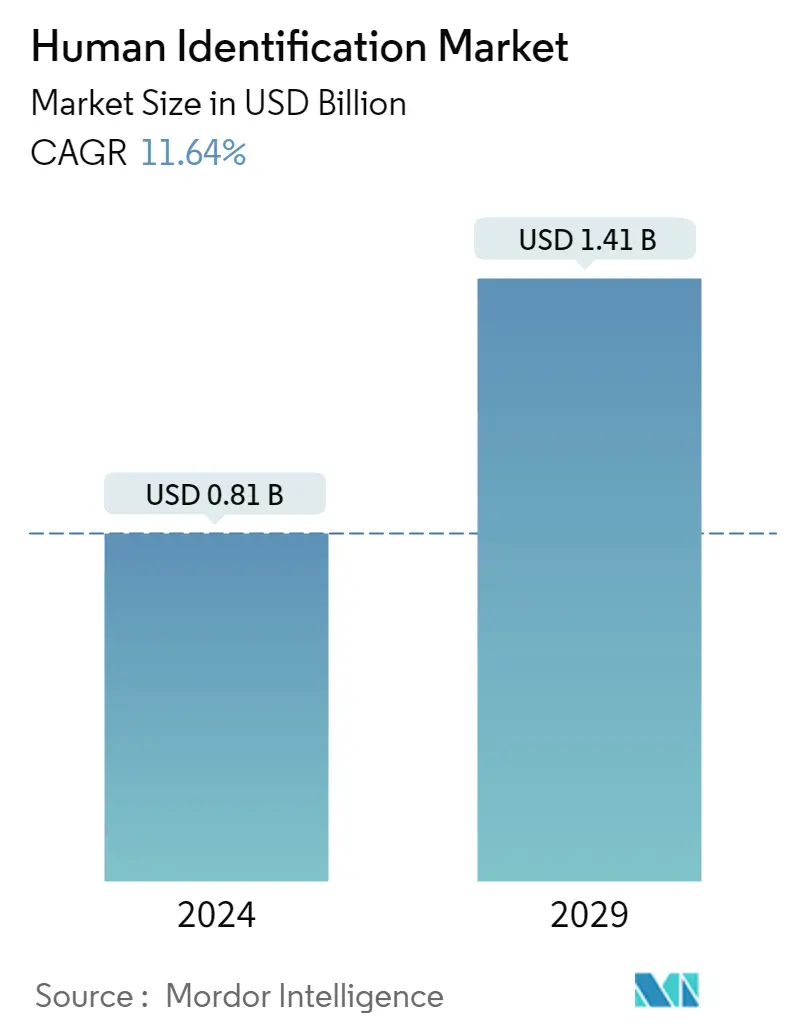Market Size of Human Identification Industry

| Study Period | 2019 - 2029 |
| Market Size (2024) | USD 0.81 Billion |
| Market Size (2029) | USD 1.41 Billion |
| CAGR (2024 - 2029) | 11.64 % |
| Fastest Growing Market | Asia-Pacific |
| Largest Market | North America |
Major Players
*Disclaimer: Major Players sorted in no particular order |
Human Identification Market Analysis
The Human Identification Market size is estimated at USD 0.81 billion in 2024, and is expected to reach USD 1.41 billion by 2029, growing at a CAGR of 11.64% during the forecast period (2024-2029).
The COVID-19 pandemic had a significant impact on the human identification market as many human identification services were hampered during the peak of COVID-19, especially forensic activities. For instance, according to the study published in the Journal of Safety Science and Resilience in February 2022, crime, and illicit economies, such as organized crime, domestic violence, terrorism, street crime, online crime, illegal markets and smuggling, human and wildlife trafficking, slavery, robberies, and burglaries decreased exponentially during the pandemic era. Thus, a decrease in crimes and investigations during the pandemic reduced the number of forensic tests, impeding the market's growth. Moreover, COVID-19 led to some revolutionary developments in the polymerase chain reaction technology and as the infection rate decreased significantly along with large-scale vaccination, the studied market was expected to recover from the COVID-19 effect and have healthy growth over the forecast period.
The market is driven by an increase in technological advancement in human identification technology, and various government initiatives and supports. There is the rapid growth of technological advancements in human identification that is highly important to make the world more secure and these techniques are extensively used in forensics for the identification of criminals. There are new techniques and technologies for DNA profiling continue to evolve every year. In May 2022, Promega's Spectrum CE System introduced a new alternative in a market capillary electrophoresis (CE) instrument. The instrument provides forensic analysts with unrivalled flexibility in how they process samples using short tandem repeat (STR) analysis by eliminating scheduling challenges and supporting chemistry from key vendors. Human identification in criminal casework and database cases now has a new option for capillary electrophoresis (CE) instruments to support their workflow.
Additionally, governments around the world have increased their support for the field due to the potential and rising demand for human identification in various industries. For instance, in March 2022, Mexican President Andrés Manuel López Obrador (AMLO) approved the formation of a National Center for Human Identification.
Furthermore, the strategic initiatives such as collaborations and product launches undertaken by the market players contribute to the market growth. For instance, in June 2021, QIAGEN N.V. reported a commercialization partnership with San Diego-based human identification specialist Verogenthat will provide customers of both companies with superior tools and comprehensive support for human identification (HID) workflows in their laboratories. Further, in March 2022, Mexican President Andres Manuel Lopez Obrador (AMLO) approved the formation of a National Center for Human Identification. In March 2022, ARUP Laboratories launched a new bioinformatics platform for better, faster next-generation sequencing test results, Rio, an advanced bioinformatics pipeline and analytics platform. Rio extends ARUP's existing cloud computing capabilities to transfer data more quickly and accurately, allowing clinicians to analyze test findings more quickly and make better medical decisions. Hence, the company's activities in the human identification segment are expected to boost the studied market growth.
Thus, the studied market growth is attributed to the above mentioned factors, and the market is expected to grow significantly over the forecast period. However, the cost of instruments and the shortage of skilled professionals might hinder market growth.
Human Identification Industry Segmentation
As per the scope of the report, human identification is a technology used to identify specificity from genetic materials. Several companies in the market specifically provide a DNA platform, which can be used in various applications. The Human Identification Market is Segmented by Technology (Polymerase Chain Reaction (PCR), Next Generation Sequencing (NGS), Nucleic Acid Purification and Extraction, Capillary Electrophoresis, Rapid DNA Analysis, and Other Technologies), Product & Service (Instruments, Assay Kits and Reagents, and Software and Services), Application (Forensic Applications, Paternity Testing, and Other Applications), and Geography (North America, Europe, Asia-Pacific, Middle East and Africa, and South America). The report also covers the estimated market sizes and trends for 17 countries across major global regions. The report offers the value (USD million) for the above segments.
| By Technology | |
| Polymerase Chain Reaction (PCR) | |
| Next Generation Sequencing (NGS) | |
| Nucleic Acid Purification and Extraction | |
| Capillary Electrophoresis | |
| Rapid DNA Analysis | |
| Other Technologies |
| By Product & Service | |
| Instruments | |
| Assay Kits and Reagents | |
| Software and Services |
| By Application | |
| Forensic Applications | |
| Paternity Testing | |
| Other Applications |
| Geography | ||||||||
| ||||||||
| ||||||||
| ||||||||
| ||||||||
|
Human Identification Market Size Summary
The human identification market is poised for significant growth over the forecast period, driven by technological advancements and increased government support. The market, which experienced a temporary setback due to the COVID-19 pandemic's impact on forensic activities, is expected to recover and expand as vaccination rates rise and infection rates decline. Innovations in DNA profiling and polymerase chain reaction technology have been pivotal in this recovery. The market's growth is further bolstered by strategic initiatives such as collaborations and product launches, which enhance the capabilities and efficiency of human identification technologies. These advancements are crucial for applications in forensics, paternity testing, and disaster victim identification, where DNA analysis plays a vital role.
North America is a key region in the human identification market, benefiting from technological advancements and increased government funding for forensic services. The United States, in particular, has seen a rise in funding to support crime laboratories and reduce DNA backlogs, which has propelled market growth. The adoption of advanced human identification techniques by government offices for forensic purposes further supports this growth. The market is moderately competitive, with several companies contributing to its expansion through product innovation and development of advanced technologies. As the demand for identification technology continues to rise due to increasing crime rates, the market is expected to experience robust growth, with North America leading the charge.
Human Identification Market Size - Table of Contents
-
1. MARKET DYNAMICS
-
1.1 Market Drivers
-
1.1.1 Technological Advancements in Human Identification System
-
1.1.2 Increasing Demand for Reducing the Time and Cost of DNA Analysis
-
1.1.3 Government Initiatives and Support
-
-
1.2 Market Restraints
-
1.2.1 Expensive Instruments
-
1.2.2 Shortage of Skilled Professionals
-
-
1.3 Porter's Five Forces Analysis
-
1.3.1 Bargaining Power of Suppliers
-
1.3.2 Bargaining Power of Buyers/Consumers
-
1.3.3 Threat of New Entrants
-
1.3.4 Threat of Substitute Products
-
1.3.5 Intensity of Competitive Rivalry
-
-
-
2. MARKET SEGMENTATION (Market Size by Value - USD million)
-
2.1 By Technology
-
2.1.1 Polymerase Chain Reaction (PCR)
-
2.1.2 Next Generation Sequencing (NGS)
-
2.1.3 Nucleic Acid Purification and Extraction
-
2.1.4 Capillary Electrophoresis
-
2.1.5 Rapid DNA Analysis
-
2.1.6 Other Technologies
-
-
2.2 By Product & Service
-
2.2.1 Instruments
-
2.2.2 Assay Kits and Reagents
-
2.2.3 Software and Services
-
-
2.3 By Application
-
2.3.1 Forensic Applications
-
2.3.2 Paternity Testing
-
2.3.3 Other Applications
-
-
2.4 Geography
-
2.4.1 North America
-
2.4.1.1 United States
-
2.4.1.2 Canada
-
2.4.1.3 Mexico
-
-
2.4.2 Europe
-
2.4.2.1 Germany
-
2.4.2.2 United Kingdom
-
2.4.2.3 France
-
2.4.2.4 Italy
-
2.4.2.5 Spain
-
2.4.2.6 Rest of Europe
-
-
2.4.3 Asia-Pacific
-
2.4.3.1 China
-
2.4.3.2 Japan
-
2.4.3.3 India
-
2.4.3.4 Australia
-
2.4.3.5 South Korea
-
2.4.3.6 Rest of Asia-Pacific
-
-
2.4.4 Middle East and Africa
-
2.4.4.1 GCC
-
2.4.4.2 South Africa
-
2.4.4.3 Rest of Middle East and Africa
-
-
2.4.5 South America
-
2.4.5.1 Brazil
-
2.4.5.2 Argentina
-
2.4.5.3 Rest of South America
-
-
-
Human Identification Market Size FAQs
How big is the Human Identification Market?
The Human Identification Market size is expected to reach USD 0.81 billion in 2024 and grow at a CAGR of 11.64% to reach USD 1.41 billion by 2029.
What is the current Human Identification Market size?
In 2024, the Human Identification Market size is expected to reach USD 0.81 billion.

